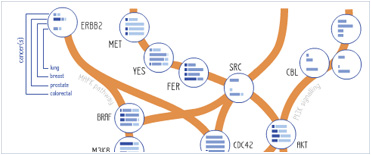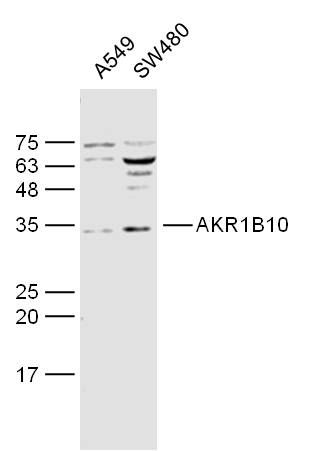AKR1B10 Polyclonal Antibody
Purified Rabbit Polyclonal Antibody (Pab)
- SPECIFICATION
- CITATIONS
- PROTOCOLS
- BACKGROUND

Application
| WB, IHC-P, IHC-F, IF, E |
|---|---|
| Primary Accession | O60218 |
| Reactivity | Rat |
| Host | Rabbit |
| Clonality | Polyclonal |
| Calculated MW | 35 KDa |
| Physical State | Liquid |
| Immunogen | KLH conjugated synthetic peptide derived from human AKR1B10 |
| Epitope Specificity | 8-110/316 |
| Isotype | IgG |
| Purity | affinity purified by Protein A |
| Buffer | 0.01M TBS (pH7.4) with 1% BSA, 0.02% Proclin300 and 50% Glycerol. |
| SUBCELLULAR LOCATION | Lysosome. Secreted. Note=Secreted through a lysosome-mediated non-classical pathway. |
| SIMILARITY | Belongs to the aldo/keto reductase family. |
| Important Note | This product as supplied is intended for research use only, not for use in human, therapeutic or diagnostic applications. |
| Background Descriptions | AKR1B10 is also known as aldose reductase-like-1 (ARL-1), small intestine reductase (SI reductase) or aldose reductase-related protein (ARP or hARP). AKR1B10 is found in many tissues but is predominantly expressed in small intestine, colon and adrenal gland. AKR1B10 is an efficient reductase for aliphatic and aromatic aldehydes. It plays a role in steroid metabolism as well as detoxification of aldehydes in digested food, and may be involved in the retinal-retinoic acid signaling pathway. AKR1B10 is prominently overexpressed in non-small cell lung carcinoma and adenocarcinoma. Cigarette smoking is an independent variable responsible for this overexpression. AKR1B10 may play a role regulating cell proliferation and cellular response to carbonyl stress. |
| Gene ID | 57016 |
|---|---|
| Other Names | Aldo-keto reductase family 1 member B10, 1.1.1.300, 1.1.1.54, ARL-1, Aldose reductase-like, Aldose reductase-related protein, ARP, hARP, Small intestine reductase, SI reductase, AKR1B10, AKR1B11 |
| Target/Specificity | Found in many tissues. Highly expressed in small intestine, colon and adrenal gland. |
| Dilution | WB=1:500-2000,IHC-P=1:100-500,IHC-F=1:100-500,IF=1:100-500,ELISA=1:5000-10000 |
| Format | 0.01M TBS(pH7.4), 0.09% (W/V) sodium azide and 50% Glyce |
| Storage | Store at -20 ℃ for one year. Avoid repeated freeze/thaw cycles. When reconstituted in sterile pH 7.4 0.01M PBS or diluent of antibody the antibody is stable for at least two weeks at 2-4 ℃. |
| Name | AKR1B10 |
|---|---|
| Synonyms | AKR1B11 |
| Function | Catalyzes the NADPH-dependent reduction of a wide variety of carbonyl-containing compounds to their corresponding alcohols (PubMed:12732097, PubMed:18087047, PubMed:19013440, PubMed:19563777, PubMed:9565553). Displays strong enzymatic activity toward all-trans- retinal, 9-cis-retinal, and 13-cis-retinal (PubMed:12732097, PubMed:18087047). Plays a critical role in detoxifying dietary and lipid-derived unsaturated carbonyls, such as crotonaldehyde, 4- hydroxynonenal, trans-2-hexenal, trans-2,4-hexadienal and their glutathione-conjugates carbonyls (GS-carbonyls) (PubMed:19013440, PubMed:19563777). Displays no reductase activity towards glucose (PubMed:12732097). |
| Cellular Location | Lysosome. Secreted. Note=Secreted through a lysosome- mediated non-classical pathway |
| Tissue Location | Found in many tissues. Highly expressed in small intestine, colon and adrenal gland. |

Thousands of laboratories across the world have published research that depended on the performance of antibodies from Abcepta to advance their research. Check out links to articles that cite our products in major peer-reviewed journals, organized by research category.
info@abcepta.com, and receive a free "I Love Antibodies" mug.
Provided below are standard protocols that you may find useful for product applications.
If you have used an Abcepta product and would like to share how it has performed, please click on the "Submit Review" button and provide the requested information. Our staff will examine and post your review and contact you if needed.
If you have any additional inquiries please email technical services at tech@abcepta.com.













 Foundational characteristics of cancer include proliferation, angiogenesis, migration, evasion of apoptosis, and cellular immortality. Find key markers for these cellular processes and antibodies to detect them.
Foundational characteristics of cancer include proliferation, angiogenesis, migration, evasion of apoptosis, and cellular immortality. Find key markers for these cellular processes and antibodies to detect them. The SUMOplot™ Analysis Program predicts and scores sumoylation sites in your protein. SUMOylation is a post-translational modification involved in various cellular processes, such as nuclear-cytosolic transport, transcriptional regulation, apoptosis, protein stability, response to stress, and progression through the cell cycle.
The SUMOplot™ Analysis Program predicts and scores sumoylation sites in your protein. SUMOylation is a post-translational modification involved in various cellular processes, such as nuclear-cytosolic transport, transcriptional regulation, apoptosis, protein stability, response to stress, and progression through the cell cycle. The Autophagy Receptor Motif Plotter predicts and scores autophagy receptor binding sites in your protein. Identifying proteins connected to this pathway is critical to understanding the role of autophagy in physiological as well as pathological processes such as development, differentiation, neurodegenerative diseases, stress, infection, and cancer.
The Autophagy Receptor Motif Plotter predicts and scores autophagy receptor binding sites in your protein. Identifying proteins connected to this pathway is critical to understanding the role of autophagy in physiological as well as pathological processes such as development, differentiation, neurodegenerative diseases, stress, infection, and cancer.


